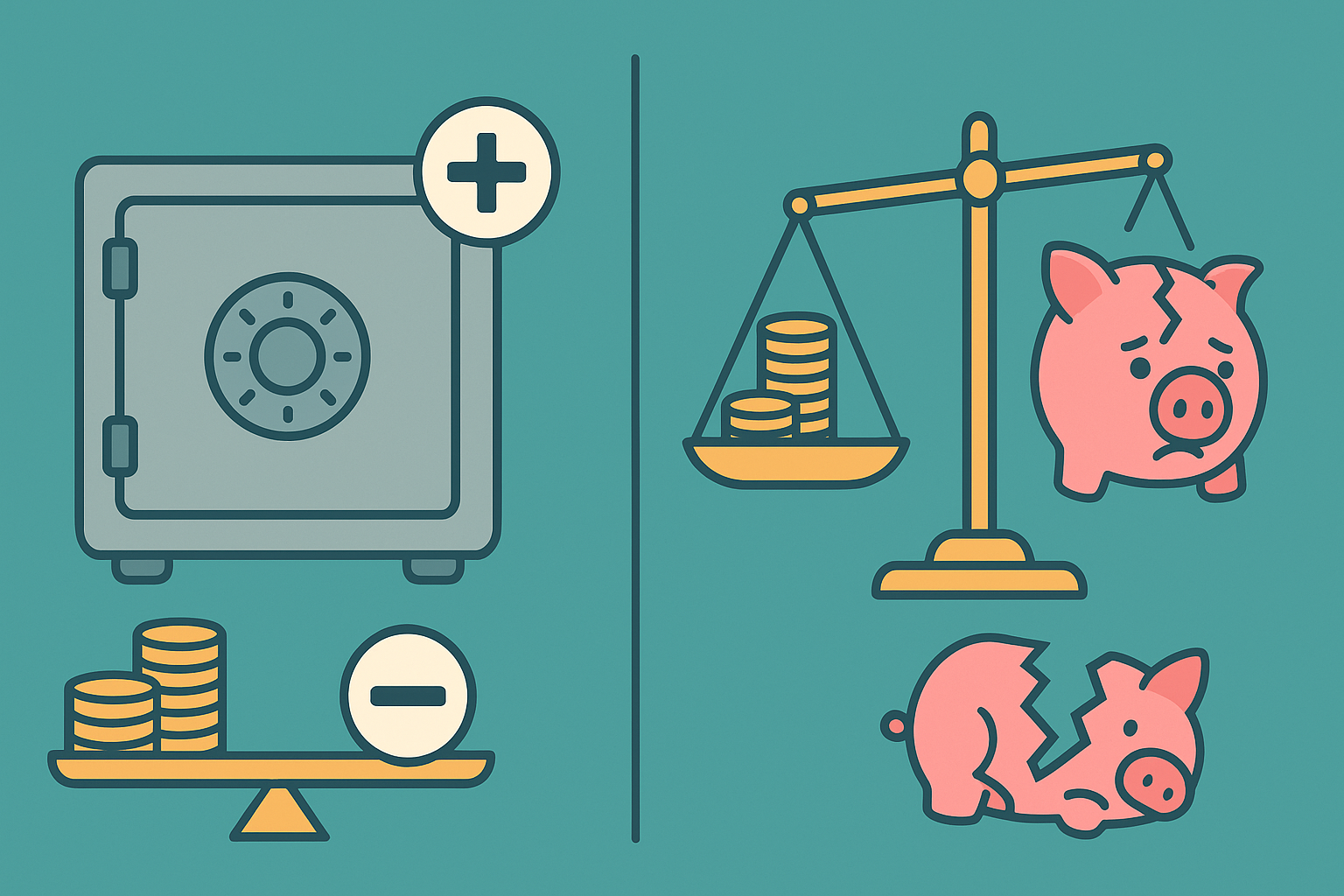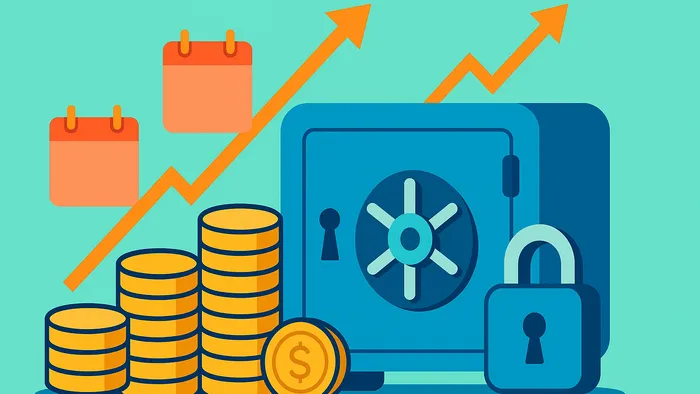Explore the benefits and types of Certificates of Deposit (CDs), a safe investment option with fixed interest rates and FDIC insurance.
- What is a CD? A CD is a savings account where you lock in money for a set term in exchange for a fixed interest rate.
- Why are CDs safe? They're FDIC-insured up to $250,000, protecting your deposit even if the bank fails.
- Interest Rates (Feb 2025): Rates vary. Top institutions offer 3.75%–5.40% APY, much higher than traditional savings accounts.
- Terms & Penalties: Terms range from 3 months to 5 years. Early withdrawals may incur penalties (e.g., 90–365 days' interest).
- Types of CDs: Options include standard, high‑yield, jumbo (for large deposits), and no‑penalty CDs.
Quick Comparison
| CD Type | Interest Rate (APY) | Term Length | Minimum Deposit |
|---|---|---|---|
| Standard CD | ~1.86% | 3 months–5 years | $500–$2,500 |
| High‑Yield CD | Up to 5.40% | 6 months–5 years | $500+ |
| Jumbo CD | Higher than standard | 3 months–5 years | $100,000+ |
| No‑Penalty CD | Slightly lower | 6 months–1 year | $500+ |
Pro Tip: Use CD laddering – invest in CDs with staggered maturity dates for flexibility and steady returns. CDs are ideal for specific financial goals, like saving for a home or retirement. Ready to lock in your savings? Let’s dive deeper.
CD Basics
Interest Rates and Returns
CD interest rates can vary a lot depending on the financial institution. Online banks usually offer higher rates compared to brick‑and‑mortar banks. For instance, as of February 2025, the national average for a 1‑year CD is 1.85%, but many online banks provide much better yields.
Here are some current rates from top institutions:
- Marcus by Goldman Sachs: 3.75%–4.50% APY
- Bask Bank: 3.75%–4.50% APY
- Synchrony Bank: 0.25%–4.35% APY
- America First Credit Union: 4.10%–4.35% APY
CD returns are calculated using this formula:
Interest = Principal × Rate × Time.
Banks may calculate interest based on a 365‑day year or adjust for leap years. Interest payouts can occur at maturity, annually, or monthly, depending on the bank.
Terms and Minimum Deposits
CD terms typically range from three months to five years, though some banks offer shorter or longer options. The minimum deposit required usually falls between $500 and $2,500.
| CD Type | Typical Term Length | Common Minimum Deposits |
|---|---|---|
| Standard CD | 3 months–5 years | $500–$2,500 |
| Jumbo CD | 3 months–5 years | $100,000+ |
When choosing a term length, think about your financial goals and the current market. If you anticipate the Federal Reserve raising rates, shorter terms might be better. On the other hand, if rates are expected to drop, locking in a longer‑term CD could be a smarter move.
Early Withdrawal Rules
Accessing your funds before a CD matures can lead to penalties, which vary by institution and term length. These penalties typically range from 90 to 365 days' worth of interest.
Here’s how some major banks handle early withdrawal penalties:
| Financial Institution | 1‑year CD | 3‑year CD | 5‑year CD |
|---|---|---|---|
| Ally Bank | 60 days interest | 90 days interest | 150 days interest |
| Bank of America | 180 days interest | 180 days interest | 365 days interest |
| Capital One 360 | 3 months interest | 6 months interest | 6 months interest |
| Discover | 6 months interest | 6 months interest | 18 months interest |
To avoid penalties, consider strategies like building a CD ladder with staggered maturity dates, opting for no‑penalty CDs, or using high‑yield savings accounts for funds you may need to access quickly.
CD Options
Standard vs. High‑Yield CDs
Standard CDs provide fixed interest rates, typically around 1.86% APY for a 12‑month term, while high‑yield CDs offer the chance to earn higher returns, with rates reaching up to 5.40% APY as of early 2025.
Flexible and Large‑Sum CDs
For savers needing flexibility, no‑penalty CDs allow withdrawals without fees, making them ideal for short‑term goals.
On the other hand, Jumbo CDs cater to those with significant funds to invest. These require minimum deposits of $100,000 or more and often provide higher rates.
Rate‑Adjustable CDs
Rate‑adjustable CDs tie their interest rates to external benchmarks, such as the prime rate, CPI, or Treasury bills. This structure can be helpful in a rising rate environment, as it allows returns to adjust with market conditions. However, performance depends on market trends.
Selecting a CD
Key Selection Criteria
Choosing the right CD depends on your financial goals and the current interest rate environment.
- Term Length: Match the CD’s maturity date with your financial plans.
- Interest Rate: Look at APYs across institutions and compare rate trends.
- Minimum Deposit: Ensure you can meet the required initial deposit.
- Access Needs: Consider whether you might need early access to funds.
- FDIC Insurance: Confirm the CD is covered by FDIC insurance.
CD Ladder Planning
Here’s how CD laddering works: divide your investment into equal parts across staggered terms (e.g., 1, 2, 3, and 4 years). When the shortest‐term CD matures, reinvest in the longest term. This approach ensures periodic access to funds while capturing higher yields.
CD Benefits and Drawbacks

CDs offer FDIC insurance up to $250,000, fixed returns, and higher yields than standard savings accounts—making them a safe, disciplined savings vehicle.
Drawbacks include limited liquidity (early‐withdrawal penalties) and returns that may lag inflation. Over the past two decades, many short‐term CDs underperformed inflation, highlighting the importance of aligning CDs with your broader financial plan.
Making Your CD Decision
Assess your timeline and access needs. If you need emergency liquidity, consider no‑penalty CDs or high‑yield savings. For defined goals, lock in competitive rates with standard or jumbo CDs, and think about laddering for optimal flexibility.








